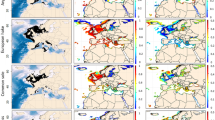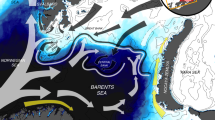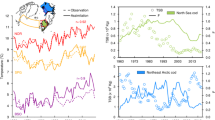Abstract
The stock of North Sea cod is under pressure because of overfishing, and we show here that it is also threatened by a decline in the production of young cod that has paralleled warming of the North Sea over the past ten years. The combination of a diminished stock and the possible persistence of adverse warm conditions is endangering the long-term sustainability of cod in the North Sea. To decrease the risk of collapse, fishing pressure must be reduced.
Similar content being viewed by others
Main
Over the past four decades, cod in the North Sea has been a valuable fishery, yielding an average of 200,000 tonnes per year. Nowadays, the catch is mainly constituted of fish that are younger than three years old, most of which are immature. This resource is currently managed by imposing landing quotas based on annual stock assessment: the latest advice from the International Council for the Exploration of the Sea (ICES) is to reduce catches by 40–60%.
For North Sea cod, apart from fish spawned in 1996 (termed the 1996 year-class), the annual number of one-year-old cod in the population (known as the recruitment) has been at or below the long-term average for over a decade1. The recruitment of cod spawned in 1997 was the lowest for 30 years. Taking account of the dependence of recruitment on stock size alone, it has been proposed2 that the collapse of this stock may be imminent, as the spawning-stock biomass is currently at a low level.
There is evidence, however, that for many fish stocks there is an environmentally driven variability in recruitment3. The recruitment of cod in the North Atlantic appears to be related to sea temperature for stocks located at the latitudinal limits of the species' distribution4. In the Northern Hemisphere, increasing temperatures are favourable for stocks at the highest latitudes but detrimental for those at the southern limit5. Cod in the North Sea are near the southern boundary of their range and, historically, strong year-classes have been associated with lower-than-average temperatures during the first half of the year (Fig. 1a).
a, Year-class strength (millions of one-year-old fish) plotted against temperature in the year spawned. The three lines show the relationship between recruitment and temperature at three levels of spawning-stock biomass (SSB) (low: 80,000 tonnes; medium: 160,000 tonnes; high: 240,000 tonnes) based upon a three-dimensional spline fit. Recruitment and SSB are from ref. 1. b, Seasonal sea-surface temperature averaged over February to June (dashed line). Horizontal lines indicate decadal average. Temperatures are derived from the Comprehensive Ocean Atmosphere Dataset and provided by the National Center for Atmospheric Research (Boulder, Colorado).
Weak year-classes have also occurred during cold years (such as 1986 and 1987), but only when the spawning-stock biomass was low. So when the spawning-stock biomass is low, as now, the likelihood of good recruitment is low and the effect of temperature is less pronounced (Fig. 1a). A change in temperature patterns might prevent the stock from being able to produce recruitments as high as those that occurred during the 1960s and 1970s, even if the spawning-stock biomass were to rebuild to the abundant levels of that period.
Since 1988, mean sea temperatures during the first half of the year in the North Sea have been higher than during the previous three decades (Fig. 1b). During this period, annual recruitment levels have been low, with the exception of 1996, when cold conditions prevailed. Since 1997, warmer conditions have returned to the North Sea and the 1997 and 1998 year-classes have coincidentally been the poorest on record1.
The North Sea cod stock is currently dominated by immature fish of less than five years old, and both the stock and fishery are dependent upon years of strong recruitment. The 1996 year-class was the strongest for over a decade but, at the present high exploitation rate of young cod, few individuals have survived to reach sexual maturity.
The combination of this exploitation with the recent changes in North Sea temperature, a low spawning-stock biomass and a stock dominated by young immature individuals, means that fishery managers must take precautionary measures6. In order to give the mature stock a chance to rebuild, fishing mortality rates need to be reduced to at least the precautionary levels advised by ICES1.
References
ICES Cooperative Research Report Report of the ICES Advisory Committee on Fishery Management (ICES, Copenhagen, 1999); on http://www.ices.dk/
Cook, R. M., Sinclair, A. & Stefánsson, G. Nature 385, 521– 522 (1997).
Cushing, D. H. Excellence in Ecology 7 (Ecology Institute, Oldendorf/Luhe, Germany, 1996).
Planque, B. & Frédou, T. Can. J. Fish. Aquat. Sci. 56, 2069–2077 ( 1999).
Coutant, C. C. Envir. Biol. Fish. 18, 161–172 (1987).
Longhurst, A. Fish. Res. 38, 101–108 ( 1998).
Author information
Authors and Affiliations
Corresponding author
Rights and permissions
About this article
Cite this article
O'Brien, C., Fox, C., Planque, B. et al. Climate variability and North Sea cod. Nature 404, 142 (2000). https://doi.org/10.1038/35004654
Issue Date:
DOI: https://doi.org/10.1038/35004654
This article is cited by
-
Addressing the dichotomy of fishing and climate in fishery management with the FishClim model
Communications Biology (2022)
-
Skilful prediction of cod stocks in the North and Barents Sea a decade in advance
Communications Earth & Environment (2021)
-
Cod and climate: a systems approach for sustainable fisheries management of Atlantic cod (Gadus morhua) in coastal Danish waters
Journal of Coastal Conservation (2019)
-
Assessing impacts of climate change on habitat suitability of Coregonus ussuriensis and other coldwater fishes in northern China
Environmental Science and Pollution Research (2019)
-
Changes in behaviour drive inter-annual variability in the at-sea distribution of northern gannets
Marine Biology (2016)
Comments
By submitting a comment you agree to abide by our Terms and Community Guidelines. If you find something abusive or that does not comply with our terms or guidelines please flag it as inappropriate.




